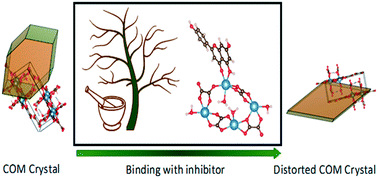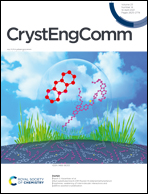Evaluation of the effect of Moringa peregrina bark on the crystal habit and size of calcium oxalate monohydrate crystals in different stages of crystallization using experimental and theoretical methods†
Abstract
A significant proportion of the world's population is afflicted by kidney stone disease, urolithiasis, often as a chronic, recurring condition. The process of biomineralization leading to urolithiasis can be regulated by various inhibitory molecules. The extract of the bark of Moringa peregrina has been considered as a modulator of calcium oxalate monohydrate (COM), the primary constituent of urolithiasis. In this study, the inhibitory potential of the COM crystallization process by the extract is evidenced by turbidity studies while control of aggregation is explored by measurement of the zeta potential. Scanning electron microscopy of the crystals formed under various conditions points to inhibitor specificity at vulnerable points in the lattice. Molecular modelling of the interaction of selected phytochemicals found in the extract with a fragment carved out of the reported crystal structure of COM was carried out to substantiate the inhibitory mechanism.



 Please wait while we load your content...
Please wait while we load your content...